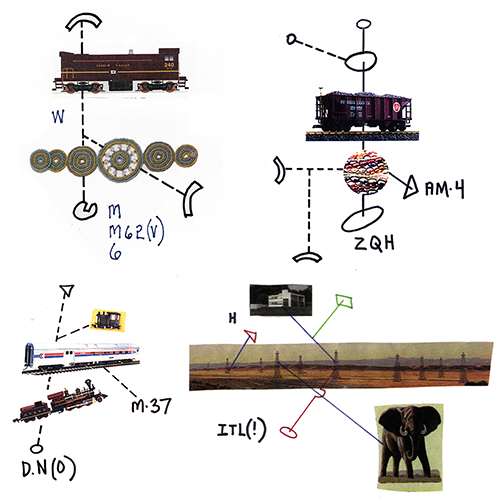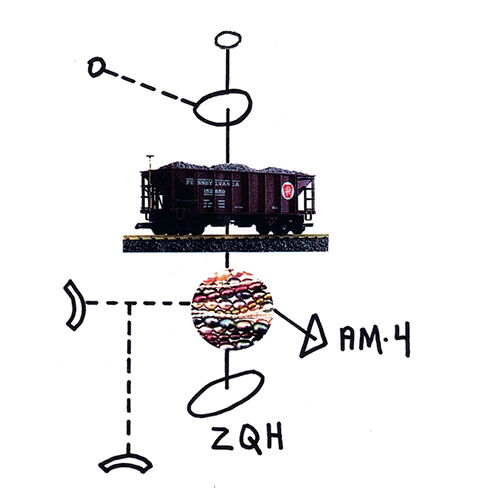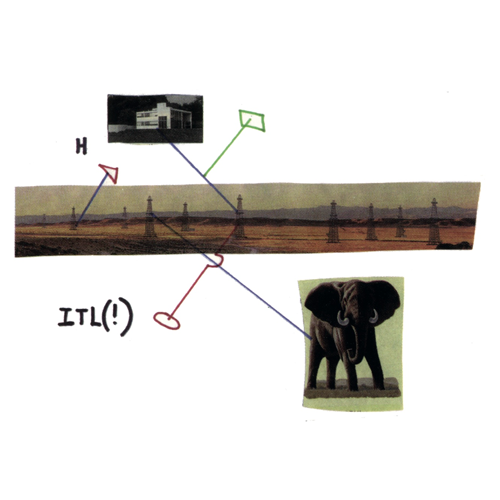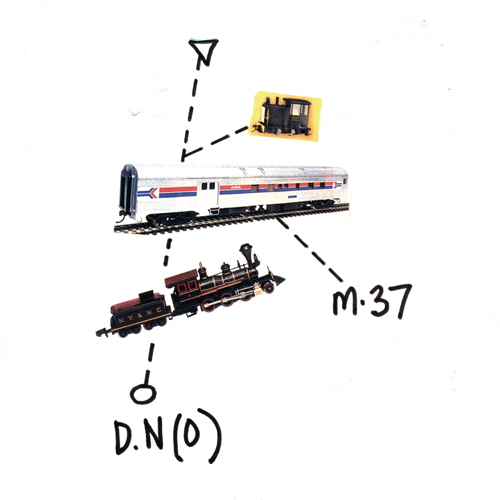
 ☰
☰
![]()


Kobe Van Cauwenberghe - electric guitar, nylon string guitar, bass guitar, synths, voice
Frederik Sakham - double bass, electric bass, voice
Elisa Medinilla - piano
Niels Van Heertum - euphonium, trumpet
Steven Delannoye - tenor saxophone, bass clarinet
Anna Jalving - violin
Teun Verbruggen - drums, percussion
Recording: at Werkplaats Walter, Brussels
Mixing: Nicolas Rombouts (Studio Caporal)
Mastering: Uwe Teichert
Production: Kobe Van Cauwenberghe & Rogé for el NEGOCITO Records
Art work / Title images: Anthony Braxton, courtesy of Tri-Centric Foundation
Lay-out: Jan De Wulf
Band photo: Kobe Wens (Rainy Days - Luxembourg, 2021)
In loving memory of Hugo De Craen (1951 – 2021), friend and friendly experiencer.
Available on double CD / double Vinyl
release double CD June 2, 2022
(ENG)
Anthony Braxton’s Ghost Trance Music lets you step into a ritual, guided by a melody without beginning or end, a stream of consciousness that serves as the central track leading into the unknown. The Ghost Trance Musics are specifically designed to function as pathways between notation and improvisation, between past, present and future, unifying Braxton's entire fascinating musical universe. It allows for a plurality of musical practices to join forces, a trance-idiomatic arena in which Braxton helps curate intuitive experiences for both performers and listeners.
Recognising the uniqueness and almost unlimited potential of Anthony Braxton’s Ghost Trance Music system, Belgian guitarist Kobe Van Cauwenberghe made it a personal mission to come to a deeper understanding of GTM and its implications for the interpreter. After his acclaimed solo album (Ghost Trance Solos, ATD10), Van Cauwenberghe invited a group of musicians to take a collective deep dive into Braxton’s musical wonderland of the Ghost Trance Musics and explore its unique communal aspects. In the summer of 2021 this Ghost Trance Septet recorded four GTM-compositions, covering the entire spectrum of the four different ’species’ of the GTM system. The result is the present double album.
The musicians of this Belgian-Danish septet have excellent reputation, whether in the art of improvisation, the interpretation of new music, or both. Braxton's work is made for exploratory instrumentalists with such expertise. After the Ghost Trance Septet's performance at the rainy days Festival on November 13, 2021 in Luxembourg, the composer (who was booked for a trio concert at the festival) was sitting in the audience and could hardly contain himself with emotion and excitement. Understandably so. I dare say he had never experienced his GTM concept from the listener's perspective as varied, elaborate and fluid as on that day.
The Ghost Trance Septet does everything right on this production. Whereby "right" is not meant in the sense of correctness, which Braxton dismisses in his recommendations to performers above, but in the sense of astonishing creative, daring, lustful, sensitive, and thrilling. How to play Braxton? Whoever holds this album in his hands can put a very convincing answer on the record player. Over and over again.
- - Excerpt from Timo Hoyer’s liner notes (Timo Hoyer is author of the book Anthony Braxton – Creative Music, Wolke Verlag, Hofheim 2021)
Full Liner Notes
How to play Anthony Braxton?
Anthony Braxton, born 1945 in the South Side of Chicago, is
undoubtedly one of the most innovative composers, multi-
instrumentalists and music theorists of our time. In the
introduction to his Catalog of Works, published in 1989, he
wrote down some general notes on how he would like his
compositions to be treated. Since then, his body of work has
undergone immense expansion and numerous astonishing
twists and turns. However, the recommendations he made to
all potential performers and interpreters remain unchanged:
“a. Have fun with this material and don’t get hung up with any
one area
b. Don’t misuse this material to have only ‘correct’ performances
without spirit or risk. [...] If the music is played too correctly
it was probably played wrong.
c. Each performance must have something unique. [...] If the
instrumentalist doesn’t make a mistake with my materials, I
say ‘Why!?’ NO mistake -- NO work!’ If a given structure concept
has been understood (on whatever level) then connect
it to something else. Try something different -- be creative
(that’s all I’m writing).
[...] and be sure to keep your sense of humor”.
Some of Braxton’s compositions from the seventies, which
he wrote mainly for his working bands (quartets, quintets),
have been interpreted relatively frequently by other musicians
over time. They now belong to the extended canon of
contemporary jazz. These pieces are only a tiny part of his
complete work, which number no less than 700 compositions,
including pieces for solo music, for duo, small and large
ensemble, small and large orchestra, choir, puppet theater,
dance performances and opera. We can consider ourselves
fortunate that Braxton himself tirelessly ensured that he was
able to perform as much of his “material” as possible and document
it on recordings.
Recordings of his works without his participation are, for a
composer of his outstanding stature, somewhat rare. His
compositions can be found on about sixty albums by other
musicians, mostly titles from his early work period, namely
the aforementioned quartet works. That’s a modest response,
one might think, considering the incessant flood of jazz releases
which include, for instance, tracks by Charlie Parker,
Thelonious Monk or John Coltrane. Comparison with the
standard-setting classics of modern jazz is inappropriate,
however. Braxton’s compositional oeuvre certainly contains
distinctive jazz components, but taken as a whole he moves
very confidently outside the jazz idiom from the very beginning
and outside any other known musical idiom as well. He
speaks of the transidiomatic essence of his work, which he
aptly calls creative music. Perhaps its most striking characteristic
is the infinitely inventive blending of notated, partially
fixed, intuitive and improvised components.
In his extremely idiosyncratic, uncompromisingly advancing
work he is primarily concerned with divergence, diversity,
transformation and restructuring (and consequently less
with homogeneity, preservation and consolidation). He has
never allowed himself the slightest bit of nostalgic recollection
or stagnation throughout his career of over fifty years. His
quoted advice to the interpreters of his music, “if a structure
concept has been understood then connect it to something
else”, corresponds to his own handling of compositions and
models. He uses them as aesthetically sophisticated modular
systems. Each one has a specific identity, but can also be
fragmented, restructured, and combined with every other
piece of his system. His hope is that the collage or synthesis
of his material will provide the players with fresh experiences,
surprising discoveries, and environments for creative participation.
Braxton’s musical world is well thought-out and at the
same time thoroughly enigmatic, a universe of incalculable
possibilities, unpredictable, open, yet completely free of arbitrariness.
None of his numerous structure concepts has fascinated and
captivated him as much as the Ghost Trance Music (GTM).
This model marks the beginning of his creative period of
Tri-Centric Modeling in the mid-nineties, which continues
to this day. The core of Tri-Centric Modeling consists of a total
of twelve music “prototypes”, not all of which have yet been
completed. The GTM has an important role in it, as it forms
the musical heart or ground floor of the whole. Between 1995
and 2006 Braxton completed 138 compositions from this
prototype. GTM encompasses a variety of musical traditions.
Inherent in it are the Ghost Dance rituals of the Native Americans,
which can last several hours, the repetitive continuums
of Minimal Music, the rhythmic diversity and trans-tonality
of African music, the parallel sound events of street parades,
the intensity and improvisational passion of jazz, and much
more. GTM is nevertheless anything but an eclectic mix of
styles or genres. It is an unmistakably independent concept
from Braxton’s creative workshop.
The scores, which can be up to eighty pages long, generally
consist of two parts. In the main part, the so-called “primary
melody” unfolds. Usually, a performance begins with all instruments
playing it in unison. This can go on indefinitely
(Braxton dreams of night-long performances), but it can
also be broken up after a few minutes or even seconds, as
determined by the ensemble. The second part of the score is
a short appendix containing “secondary material”. These are
mostly three or four six-line miniature compositions. Braxton
expects a creative, quite liberal handling of the material.
In the notation of the primary melody suggestions are made
(always with the option to ignore them), at which points of
the performance one could move away from the main route
to the paths of the secondary material. These options are indicated
by triangles placed in the head of a note. And there
are more symbols as well.
If a square is visible on a note, it signals to the performers that
they can include passages from any of Braxton’s compositions.
The musicians select this “tertiary material” in advance
and then decide during the performance with whom from
the ensemble they want to interpret something from it. Finally
a third symbol, the circle, signifies that the performers
may engage in a period of improvisation. Again, they decide
during the performance whether or not they actually want to
improvise alone or with others. Braxton’s understanding is
that GTM is not a platform for extensive solo improvisation.
He hopes for imaginative, incisive contributions that are in
service of the overall sound architecture. Van Cauwenberghe’s
Ghost Trance Septet follows this guideline on this record
with bravura. All of the musicians have their spotlight moments
on this album. But no one tries to advance themselves
into the foreground with soloistic extravagances.
The GTM model has undergone substantial changes during
Braxton’s eleven years of involvement with it. There are at
least four different manifestations, which are called “species”,
with one exponent of each heard on this release. The differences
primarily concern the primary melody. The first GTM
compositions radiate a strict regularity, the – in the score not
predefined – tempo is consistant, the beat steady. With each
species this regularity is rhythmically shaken up. In the most recent compositions, the melody is made up of a number of
rapidly swirling figures that have as much to do with a trance
state as a roller coaster ride has to do with yoga exercises.
Braxton conducted a GTM ensemble for the last time 2012 at
the Biennale Musica in Venice. Since then, he has drawn on
the 138 compositions in other conceptual contexts, but the
GTM model as such is history for him. Who will carry it into
the future? Until recently, the younger generation of creative
musicians did not seem to show interest in the model that
one might have expected in view of its overwhelming potential.
But the tide is gradually beginning to turn. We owe this
not solely, but in the main, to Belgian guitarist Kobe Van Cauwenberghe.
In 2020, on his CD Ghost Trance Solos (ATD10),
he managed the feat of creating sparks out of the intricate
structures of GTM as a soloist. Inevitably, one began to wonder
what this fabulous musician, trained in contemporary
composed and improvised music, might be able to pull out of
the model with an ensemble of like-minded musicians. Now
we know!
The musicians of this Belgian-Danish septet have excellent
reputation, whether in the art of improvisation, the interpretation
of new music, or both. Braxton’s work is made for
exploratory instrumentalists with such expertise. After the
Ghost Trance Septet’s performance at the rainy days Festival
on November 13, 2021 in Luxembourg, the composer (who
was booked for a trio concert at the festival) was sitting in the
audience and could hardly contain himself with emotion and
excitement. Understandably so. I dare say he had never experienced
his GTM concept from the listener’s perspective as
varied, elaborate and fluid as on that day.
In Luxembourg the septet performed Composition No. 255.
On this extraordinary studio recording this composition extends
over the first side. At the beginning we are drawn into
the stoic lockstep of the primary melody, which staggers at
certain intervals, indicating that No. 255 is an example of the
second GTM species. Shortly before the unison is about to
dissolve for the first time, after about three minutes, numbers,
syllables and words can be heard briefly spoken or if you will,
sung. That means that this piece also belongs to the subspecies
of Syntactical Ghost Trance Music, whose onomatopoetic
libretto can be executed in whole or in part, or ignored (a
fully sung choral version can be heard on Braxton’s box set
GTM (Syntax) 2017 (NBH908), an entirely instrumental version
for instance on GTM (Iridium) 2007, Vol. 2 (NBH025);
the recommendable comparison of the versions reveals a
lot about the elasticity of Braxton’s compositions). It is pure
pleasure to listen to the septet as it strings together one sonic
shape-shift after the other. Braxton’s older compositions
are skillfully, yet often discreetly, incorporated into the meandering
stream – the highly accelerated No. 34, the quartet
earworm No. 40f as well as No. 168, once written for a duo
session with James Emery – in order to flow smoothly into
the home port of the primary melody.
On the second side of the record we experience an even
more magnificent miracle of emergence. From beginning
to end the structures, the atmospheres and the emotionality
of the music change constantly. The primary melody of
Composition No. 358 introduced at the beginning conveys
the feeling that one is moving on a shaky ground that could
break away or mutate into something else at any time. And it
does. The piece was written by Braxton for a three-day engagement
of his 12+1tet at Manhattan’s Iridium. The fiery live
version is documented on the terrific box set 9 Compositions
(Iridium) 2006 (FH12-04-03-001). This is an example of
the fourth species. This last GTM series bears the telling names
Accelerator Class or, in this case, Accelerator Whip. The
corresponding works are characterized by a good portion of
rhythmic uncertainty and divergence. The septet succeeds in
shaping every single moment in a distinctive way. Forms are
created, overwritten, dissolved, sometimes at the same time.
In certain moments the mood is playful and dreamy, then
suddenly the coordinates shift, entropy rises, bubbles and
evaporates. Familiar melodic fragments mix into the atonal
hustle and bustle. After about eight minutes, the fancy march
No. 58, one of Braxton’s most charming orchestral pieces, arrives
from nowhere, mesmerizing the entire ensemble and
throwing it into carnivalesque turmoil for a few minutes. A
section from No. 168 is again interspersed. The musicians
also draw additional rhythmic inspiration from No. 108d, one
of four Pulse Track Structures with which Braxton once used
to destabilize the metric balance of his quartet music.
When the breathtaking lockstep of Composition No. 193
greets us on the third side of this double album, there is no
doubt that we are dealing with the first GTM species. It takes
about five minutes for everyone in the ensemble to gradually
detach themselves from the primary melody. As if they
needed a refreshing breather, they slow down the music and
let the sonic substance become fleeting and transparent like
a fascinating mirage. With new energy and like adventurous
travelers, they pick up speed again afterwards. Compared to
Braxton’s original version, to be heard on Tentet (New York)
1996 (BH004), the basic melody disappears relatively often
from the listening field, but nevertheless it seems to run
through the colorful activities like a red thread. The Pulse
Track Structure No. 108c, the airy slow pulse piece No. 48 and,
shortly before the finale, the dynamic repetition patterns of
No. 6f serve as collage material.
Finally there remains the third species, which, compared to
the second, shows more polyrhythm and incoherence and
less regularity and stringency. The Ghost Trance Septet selected
a previously undocumented example, Composition No.
264. With a fine feeling for contrasting timbres (the choice
of instruments is almost always left to the musicians in the
GTM) and exciting tempo changes, the territories of the score
are executed. The Pulse Track Structure No. 108a, small parts
of the duos No. 101 and No. 304 and two well-known quartet
pieces serve as enrichment material. One of them, the “postbe-
bop thematic structure”, as Braxton says in his Composition
Notes, of No. 40b stands out clearly and distinctly from
the rest of the proceedings after about nine minutes. The repetitive
motif of No. 40o, on the other hand, appears like a
fleeting memory a minute before the end, and no sooner has
it been perceived than it has disappeared.
The Ghost Trance Septet does everything right on this production.
Whereby “right” is not meant in the sense of correctness,
which Braxton dismisses in his recommendations
to performers above, but in the sense of astonishing creative,
daring, lustful, sensitive, and thrilling. How to play Braxton?
Whoever holds this album in his hands can put a very convincing
answer on the record player. Over and over again.
TIMO HOYER
Author of the book Anthony Braxton – Creative Music (Wolke
Verlag, Hofheim 2021)

SIDE A
composition 255

SIDE B
composition 358

SIDE C
composition 193
(+ 108C + 48 + 6F)
Anthony Braxton - 24:47.226

SIDE D
composition 264
total time - 95:22
eNR105 © 2022
DOWNLOADABLES
for professional use
download Band photo
© Kobe Wens (Rainy Days - Luxembourg, 2021)
download track artwork composition 255
© Anthony Braxton and Tri-Centric Foundation
download track artwork composition 358
© Anthony Braxton and Tri-Centric Foundation
download track artwork composition 193
© Anthony Braxton and Tri-Centric Foundation
download track artwork composition 264
© Anthony Braxton and Tri-Centric Foundation